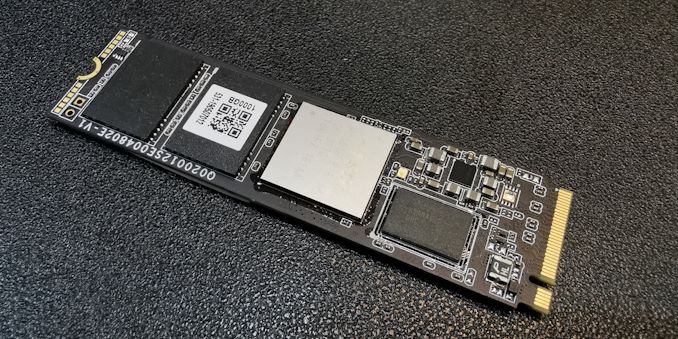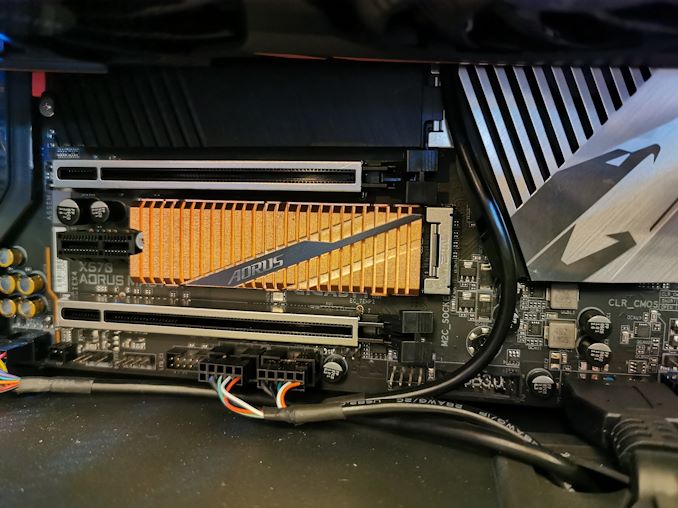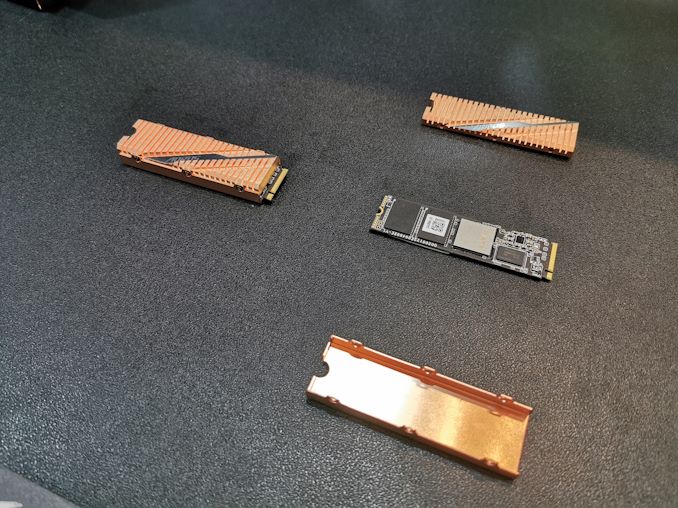GIGABYTE’s PCIe 4.0 SSD Uses 77g of Copper Due to 8W TDP, up to 2TB
by Ian Cutress on June 4, 2019 11:00 AM EST- Posted in
- SSDs
- Gigabyte
- Trade Shows
- Phison
- PCIe 4.0
- Computex 2019
- PS5016-E16

One of the hot ticket items at this year’s Computex was the range of PCIe 4.0 storage devices available. All of them except one was built on the Phison E16 reference design, making most of them pretty much the same, save the NAND being used. We reported on GIGABYTE’s design before, when it was simply part of a press release, but we got to see one on the show floor later in the week.
The most obvious difference between all of the Phison turn-key solutions between the vendors will be in the heatsink designs. Because the E16 controller is just Phison’s high-end design with the PCIe 3.0 PHY replaced with the PCIe 4.0 PHY, it stresses the actual compute parts of that controller to the limit, and we get a toasty design. In order to combat this toastyness, GIGABYTE has added a 77g copper cooler to their drive.
We are told that the 5 GB/s read/write limit is actually caused by the controller rather than the NAND, so with a new controller next year we expect to get closer to the PCIe 4.0 x4 bus limits. But for now, we have this 8W TDP design that requires substantial cooling. We’re told that it can be used for laptops, but it is unlikely without being attached to the main CPU heatpipe. GIGABYTE paired the SSD with its Quad M.2 PCIe 4.0 add-in card so show that the speeds can ramp up quite a lot, almost up to 15 GB/s.
GIGABYTE is one vendor that will be supplying its drives in AMD’s Ryzen 3000 press kits, and the company expects to offer 500GB, 1TB, and 2TB models to the market in July.
| Want to keep up to date with all of our Computex 2019 Coverage? | ||||||
 Laptops |
 Hardware |
 Chips |
||||
| Follow AnandTech's breaking news here! | ||||||


















19 Comments
View All Comments
DyneCorp - Wednesday, June 5, 2019 - link
What, are you serious? Why don't you create a better product?PeachNCream - Wednesday, June 5, 2019 - link
Yes I'm serious. SSDs need to work in laptops because of the decline of desktop hardware sales and their corner use cases (expensive and small numbers of gaming boxes and a few professional workstations) and relying on a bulky heatsink to keep the drive from suffering from thermal death is a stupid move in a world where the standard corporate and home computer is some sort of laptop PC.Skeptical123 - Wednesday, June 5, 2019 - link
DyneCorp just ignore PeachNcream he does not know what he is talking about (but clearly things he does). Of course SSDs should be able to work in laptop but you seem to be thinking cutting edge PCIe gen4 NVMe drives meant for severs and desktop applications have to be work in laptops to be viable. That is not the case. There are not any laptops on the market that even support PCIe gen4 nor have any even been announced (that I have seen). Laptops will of course come out that support the new standard but also of course SSDs that support these applications will come out in the same time frame.PeachNCream - Thursday, June 6, 2019 - link
I don't have enough hands to facepalm an adequate amount for what you just did and its clear to me that even after you read your comment over again and try to consider the context in which you made it, you likely won't get it.Skeptical123 - Wednesday, June 5, 2019 - link
What makes you think they are not designing a better product? This is simple the best product they could get out in this time frame. I don't need to explain to you why a company and consumers will take some inconvenience to get the latest tech now rather than waiting for better stuff to come out. Also what is there to analyze??"Good going people, no one will analyze that even a little bit." They mention the weight of the metal. There is not much other info they can give. Other cooling specs depend on what's around the drive and get too technical.Foeketijn - Wednesday, June 5, 2019 - link
It wouldn't be the first time, when reviewers find the performance can be improved by removing the heatsink.Skeptical123 - Wednesday, June 5, 2019 - link
What makes you think the performance can be improved by removing the heatsink? Also without a heatsink or a direct stream of cold air flowing over the drive it will probably thermal throttle or burn up.edzieba - Wednesday, June 5, 2019 - link
For a mere 8W, that is a hilariously overspecced heatsink.Skeptical123 - Wednesday, June 5, 2019 - link
I mean what do you expect? How would you make it smaller? The heatsink in the photos is just a few mm think peace of mental surround the drive. The only way it could be smaller would be for a single heatsink to be apoxeed to the controller chip. Which would look weird. Also that may not allow for enough cooling in applications where cooling to the drive is restricted because it's say mounted under a GPU. Also there are the looks, anything smaller would not cover the drive and not look as "clean" to most people.